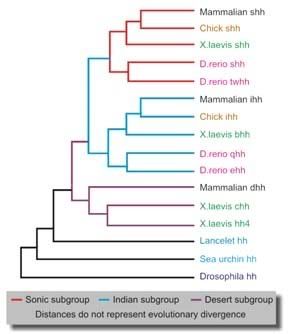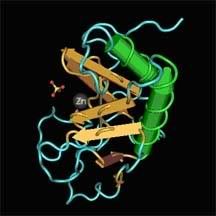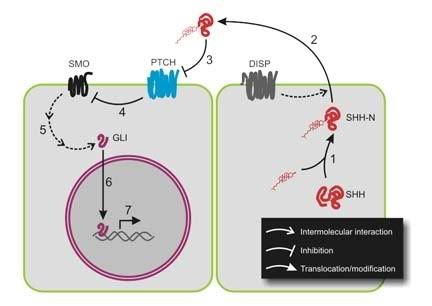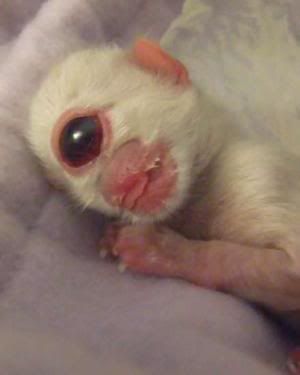
One of the genes I’m researching in the Stenkamp lab is the sonic hedgehog gene. We're interested in deciphering how it regulates retinal development. Many people laugh when they hear that I’m studying sonic hedgehog, it sounds like some impulsive video gamer’s dream job, but the sonic hedgehog gene name actually has a logical origin.
 Hedgehog proteins, in general, are best known for their role in regulating development by creating concentration gradients. The first hedgehog gene was discovered through a mutation in Drosophila melanogaster, the fruit fly. The mutation caused a bunchy, spiky appearance in the embryo and so researchers gave it the name “hedgehog.” Soon more and more hedgehog analogues were found in other species. These hedgehog-like proteins were first given the names of actual known hedgehog species, such as desert and Indian hedgehog, but when those ran thin all that seemed left was that notorious Sega character: Sonic the Hedgehog.
Hedgehog proteins, in general, are best known for their role in regulating development by creating concentration gradients. The first hedgehog gene was discovered through a mutation in Drosophila melanogaster, the fruit fly. The mutation caused a bunchy, spiky appearance in the embryo and so researchers gave it the name “hedgehog.” Soon more and more hedgehog analogues were found in other species. These hedgehog-like proteins were first given the names of actual known hedgehog species, such as desert and Indian hedgehog, but when those ran thin all that seemed left was that notorious Sega character: Sonic the Hedgehog. Sonic hedgehog, as it turns out, is one of the best studied morphogenic genes around. The sonic hedgehog gene produces the sonic hedgehog protein (note: genes are italicized and proteins of the same name are not), which binds to cellular receptors as a ligand and plays key roles in vertebrate organogenesis. The developmental patterning of many systems is dependent upon hedgehog proteins, including the limbs, the midline of the central nervous system, and the thalamus.
Sonic hedgehog, as it turns out, is one of the best studied morphogenic genes around. The sonic hedgehog gene produces the sonic hedgehog protein (note: genes are italicized and proteins of the same name are not), which binds to cellular receptors as a ligand and plays key roles in vertebrate organogenesis. The developmental patterning of many systems is dependent upon hedgehog proteins, including the limbs, the midline of the central nervous system, and the thalamus.Sonic hedgehog (shh) proteins work to create correct developmental patterning through diffusion gradients. In the limb, shh is secreted at the zone of polarizing activity, creating higher concentrations of shh protein in the fifth digit and none in the first, with a gradient in between. This gradient is responsible for distinguishing the posterior and anterior ends of the limb. In the absence of shh, the digits will not differentiate correctly resulting in a symmetrical, deformed hand, paw, or flipper (depending on who you are).
Similarly, shh signaling is required for proper patterning in the central nervous system. In the neural tube, shh proteins bind to patched (ptc) and smoothened (smo) to begin the hedgehog signal transduction pathway, below:

In humans, mutations in the sonic hedgehog gene cause holoprosencephaly type 3 due to the loss of the ventral midline. As a result, the cerebral hemispheres of the brain do not divide, nor does the eye. Usually, death occurs in utero, but less severe cases may allow the organism to survive for some time after birth, such as in the disturbing case of the sad little cyclopic kitty below:

In zebrafish, a deletion of the sonic hedgehog gene will also result in gross morphogenic differences during development. The embryo has a truncated body type, shrunken head and eyes, poor (if any) lens and photoreceptor development, and often dies around three days post fertilization. This is the mutant I am primarily investigating in the Stenkamp laboratory.
Sonic hedgehog also plays a role in the adult organism. It is known to signal hair follicles into the active phase (geeze, maybe I could use some shh protein for my sluggish follicles!). Procter & Gamble are currently developing a hedgehog agonist to treat certain types of baldness. Aside from hair growth, shh controls cell division in stem cells and is currently under investigation for its use in maximizing the potential of stem-cell research. It is also implicated in certain types of cancer, as in some instances its over expression may result in uninhibited cell division.
Sources:
http://www.futurepundit.com/archives/002462.html
http://www.bio.davidson.edu/Courses/Molbio/MolStudents/spring2003/Watson/Sonichedgehog.htm
Bumcrot, Takada and McMahon. “Proteolytic processing yields two secreted forms of sonic hedgehog.” Mol. Cell. Biol. 1995
Currie and Ingham. “Induction of a specific muscle cell type by a hedgehog-like protein in zebrafish.” Nature. 1996.
Kolpak, Zhang, and Bao. “Sonic hedgehog has a dual effect on the growth of retinal ganglion axons depending on its concentration.” J Neurosci. 2005
Perron, Boy, Amato, et. al. “A novel function for Hedgehog signalling in retinal pigment epithelium differentiation.” Development. 2003
Scholpp, Wolf, Brand, and Lumsden. “Hedgehog signalling from the zona limitans intrathalamica orchestrates patterning of the zebrafish diencephalon.” Development. 2006
Stenkamp, Frey, and Mallory. Developmental Dynamics. “Embryonic Retinal Gene Expression in Sonic-You Mutant Zebrafish.” Developmental Dynamics.
All images from wikipedia, where, although the information can be unreliable and should be double checked elsewhere, the pictures are absolutely free!


1 Comments:
Hi! I think I'm dealing with the consequences of a hedgehog inadequecy. My three year old has Down Syndrome (Trisomy 21). Someone just posted this info. to my DS list - http://journals.aol.com/patoco2/TrisomyDisorders/entries/2006/02/20/treatment-of-down-syndrome-restores-nerve-growth/981.
I am busily trying to "counteract" the effects of trisomy 21 on my son. And in his case... he was genetically predisposed to react to the toxins in vaccines. We had him tested extensively last year and we have a huge report I'm trying to figure out. Dr. Amy Yasko is having success in helping people counteract their genetic flaws by using supplements. She's helping alot of kids with autism. My son is gradually coming out of autism. But boy would I love to know how to get him "out" of Trisomy 21!. :) Any thoughts on how a person could increase their levels of shh in the brain?
Also... here's a link http://www.meiogen.com/Articles/BostonGlobe.asp to info. on a Dr. Maroun who is studying treating Trisomy 21 patients with interferon. Protein figures in heavily with Down's. Apparently they're low in a protein, Shh, at birth and across the board their brains have too much beta-amyloid (like Alzheimer's victims) which is another protein.
I am not a biochem whiz. I actually stink at it. But out of necessity I keep trying to undersand what is going on with my Jack. In the meantime... he's a little cutie... starting to talk (again) as he heals from autism. We give him alot of supplements. He LOVES to "torment" his 13 year old sister. He's a gift.
Any thoughts or input you might have would be appreciated!
By Anonymous, at 8:46 PM
Anonymous, at 8:46 PM
Post a Comment
<< Home